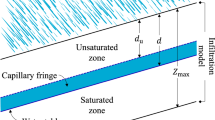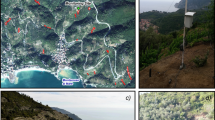Abstract
Rainfall-induced shallow landsliding is a persistent hazard to human life and property. Despite the observed connection between infiltration through the unsaturated zone and shallow landslide initiation, there is considerable uncertainty in how estimates of unsaturated soil-water retention properties affect slope stability assessment. This source of uncertainty is critical to evaluating the utility of physics-based hydrologic modeling as a tool for landslide early warning. We employ a numerical model of variably saturated groundwater flow parameterized with an ensemble of texture-, laboratory-, and field-based estimates of soil-water retention properties for an extensively monitored landslide-prone site in the San Francisco Bay Area, CA, USA. Simulations of soil-water content, pore-water pressure, and the resultant factor of safety show considerable variability across and within these different parameter estimation techniques. In particular, we demonstrate that with the same permeability structure imposed across all simulations, the variability in soil-water retention properties strongly influences predictions of positive pore-water pressure coincident with widespread shallow landsliding. We also find that the ensemble of soil-water retention properties imposes an order-of-magnitude and nearly two-fold variability in seasonal and event-scale landslide susceptibility, respectively. Despite the reduced factor of safety uncertainty during wet conditions, parameters that control the dry end of the soil-water retention function markedly impact the ability of a hydrologic model to capture soil-water content dynamics observed in the field. These results suggest that variability in soil-water retention properties should be considered for objective physics-based simulation of landslide early warning criteria.









Similar content being viewed by others
References
Baum RL, Godt JW (2010) Early warning of rainfall-induced landslides and debris flows in the U.S.A. Landslides 7(3):259–272. https://doi.org/10.1007/s10346-009-0177-0
Baum RL, Godt JW, Savage WZ (2010) Estimating the timing and location of shallow rainfall-induced landslides using a model for transient, unsaturated infiltration. J Geophys Res Earth Surf 115(F3):1–26. https://doi.org/10.1029/2009JF001321
Baum RL, McKenna JP, Godt JW, Harp EL, McMullen SR (2005) Hydrologic monitoring of landslide-prone coastal bluffs near Edmonds and Everett, Washington, 2001–2004. U.S. Geological Survey Open-File Report 2005–1063, 42 p
BeVille SH, Mirus BB, Ebel BA, Mader GC, Loague K (2010) Using simulated hydrologic response to revisit the 1973 Lerida Court landslide. Environ Earth Sci 62(6):1249–1257. https://doi.org/10.1007/s12665-010-0448-z
Bogaard TA, Greco R (2016) Landslide hydrology: from hydrology to pore pressure. WIREs Water 3(3):439–459. https://doi.org/10.1002/wat2.1126
Bordoni M, Meisina C, Valentino R, Lu N, Bittelli M, Chersich S (2015) Hydrological factors affecting rainfall-induced shallow landslides: from the field monitoring to a simplified slope stability analysis. Eng Geol 193:19–37. https://doi.org/10.1016/j.enggeo.2015.04.006
California Department of Transportation (2009) Caldecott improvement project geotechnical baseline report. Department of Transportation, California 100 p
Capparelli G, Versace P (2011) FLaIR and SUSHI: two mathematical models for early warning of landslides induced by rainfall. Landslides 8(1):67–79. https://doi.org/10.1007/s10346-010-0228-6
Casadei M, Dietrich WE, Miller NL (2003) Testing a model for predicting the timing and location of shallow landslide initiation in soil-mantled landscapes. Earth Surf Process Landf 28(9):925–950. https://doi.org/10.1002/esp.470
Chen P, Mirus BB, Lu N, Godt JW (2017) Effect of hydraulic hysteresis on the stability of infinite slopes under steady infiltration. J Geotech Geoenviron 143(9):1–10. https://doi.org/10.1061/(ASCE)GT.1943-5606.0001724
Collins BD, Stock JD, Foster KA, Whitman MPW, Knepprath NE (2012) Monitoring the subsurface hydrologic response for precipitation-induced shallow landsliding in the San Francisco Bay area, California, U.S.A. In: Eberhardt et al (eds) Landslides and engineering slopes: protecting society through improved understanding. Taylor and Francis Group, London, pp 1249–1255
Collins BD, Znidarcic D (2004) Stability analyses of rainfall induced landslides. J Geotech Geoenviron 130(4):362–372. https://doi.org/10.1061/(ASCE)1090-0241(2004)130:4(362)
De Vita P, Napolitano E, Godt JW, Baum RL (2013) Deterministic estimation of hydrological thresholds for shallow landslide initiation and slope stability models: case study from the Somma-Vesuvius area of southern Italy. Landslides 10(6):713–727. https://doi.org/10.1007/s10346-012-0348-2
Dibblee TW, Minch JA (2005) Geologic map of the Oakland East quadrangle, Contra Costa and Alameda Counties, California. Dibblee Geological Foundation Map DF-160, 1:24000
Ebel BA, Loague K, Borja RI (2010) The impacts of hysteresis on variably saturated hydrologic response an slope failure. Environ Earth Sci 61(6):1215–1225. https://doi.org/10.1007/s12665-009-0445-2
Fayer MJ (2000) UNSAT-H version 3.0: unsaturated soil water and heat flow model theory. Pacific Northwest National Laboratory Report 13249. doi:https://doi.org/10.1007/s12665-009-0445-2
Freeze RA, Cherry JA (1979) Groundwater. Prentice Hall, Englewood Cliffs 604 p
Gerke HH (2006) Preferential flow descriptions for structured soils. J Plant Nutr Soil Sci 169(3):382–400. https://doi.org/10.1002/jpln.200521955
Germann PF, Hensel D (2006) Poiseuille flow geometry inferred from velocities of wetting fronts in soils. Vadose Zone J 5(3):867–876. https://doi.org/10.2136/vzj2005.0080
Godt JW, McKenna JP (2008) Numerical modeling of rainfall thresholds for shallow landsliding in the Seattle, Washington area. In: Baum RL et al. (eds) Landslides and engineering geology of the Seattle, Washington area, Reviews in Engineering Geology, vol 20. Geological Society of America, Boulder, pp 121–135. https://doi.org/10.1130/2008.4020(07)
Gomes GJC, Vrugt JA, Vargas Jr EA, Camargo JT, Velloso RQ, van Genuchten MTh (2017) The role of uncertainty in bedrock depth and hydraulic properties on the stability of a variably-saturated slope. Comput Geotech 88:222–241. doi:https://doi.org/10.1016/j.compgeo.2017.03.016
Greco R, Comegna L, Damiano E, Guida A (2017) Investigation on the hydraulic parameters affecting shallow landslide triggering in a pyroclastic slope. In: Mikoš M et al. (eds) Fourth world landslide forum, Advancing culture of living with landslides, vol 2. pp 659–667. https://doi.org/10.1007/978-3-319-53498-5
Greco R, Comegna L, Damiano E, Guida A, Olivares L, Picarelli L (2014) Conceptual hydrological modeling of the soil-bedrock interface at the bottom of the pyroclastic cover of Cervinara (Italy). Procedia Earth Planet Sci 9:122–131. https://doi.org/10.1016/j.proeps.2014.06.007
Hargreaves GH (1994) Defining and using reference evapotranspiration. J Irrig Drain Eng 120(6):1132–1139. https://doi.org/10.1061/(ASCE)0733-9437(1994)120:6(1132)
Lanni C, McDonnell J, Hopp L, Rigon R (2013) Simulated effect of soil depth and bedrock topography on near-surface hydrologic response and slope stability. Earth Surf Process Landf 38(2):146–159. https://doi.org/10.1002/esp.3267
Lu N, Godt JW (2008) Infinite-slope stability under unsaturated conditions. Water Resour Res 44(11):1–13. https://doi.org/10.1029/2008WR006976
Lu N, Godt JW (2013) Hillslope hydrology and stability. Cambridge University Press, Cambridge, 437 p. https://doi.org/10.1017/CBO9781139108164
Lu N, Kaya M, Collins BD, Godt JW (2013) Hysteresis of unsaturated hydromechanical properties of a silty soil. J Geotech Geoenviron 139(3):507–510. https://doi.org/10.1061/(ASCE)GT.1943-5606.0000786
Lu N, Likos WJ (2004) Rate of capillary rise in soils. J Geotech Geoenviron Eng 136(6):646–650. https://doi.org/10.1061/(ASCE)1090-0241(2004)130:6(646
Marquardt DW (1963) An algorithm for least-squares estimation of non-linear parameters. J Soc Ind Appl Math 11(2):431–441. https://doi.org/10.1137/0111030
McGuire LA, Rengers FK, Kean JW, Coe JA, Mirus BB, Baum RL, Godt JW (2016) Elucidating the role of vegetation in the initiation of rainfall-induced shallow landslides: insights from an extreme rainfall event in the Colorado Front Range. Geophys Res Lett 43(17):9084–9092. https://doi.org/10.1002/2016GL070741
Mirus BB (2015) Evaluating the importance of characterizing soil structure and horizons in parameterizing a hydrologic process model. Hydrol Process 29(21):4611–4623. https://doi.org/10.1002/hyp.10592
Mirus BB, Ebel BA, Loague K, Wemple BC (2007) Simulated effect of a forest road on near-surface hydrologic response: redux. Earth Surf Process Landf 32(1):126–142. doi:1002/esp.1387
Mirus BB, Smith JB, Baum RL (2017) Shallow landslide assessment of coastal bluffs along Puget Sound using a physics-based hydro-mechanical model. In: De Graff JV, Shakur A (eds) Landslides: putting experience, knowledge and emerging technologies into practice. Association of Environmental & Engineering Geologists, Roanoke, pp 442–454
Mualem Y (1976) A new model for predicting the hydraulic conductivity of unsaturated porous media. Water Resour Res 12(3):513–522. https://doi.org/10.1029/WR012i003p00513
Napolitano E, Fusco F, Baum RL, Godt JW, De Vita P (2016) Effect of antecedent-hydrological conditions on rainfall triggering debris flows in ash-fall pyroclastic mantled slopes of Campania (southern Italy). Landslides 13(5):967–983. https://doi.org/10.1007/s10346-015-0647-5
Nimmo JR (2012) Preferential flow occurs in unsaturated conditions. Hydrol Process 26(5):786–789. https://doi.org/10.1002/hyp.8380
Papa MN, Medina V, Ciervo F, Bateman A (2013) Derivation of critical rainfall thresholds for shallow landslides as a tool for debris flow early warning systems. Hydrol Earth Syst Sci 17(10):4095–4107. https://doi.org/10.5194/hess-17-4095-2013
Richards LA (1931) Capillary conduction of liquids through porous mediums. J Appl Phys 1(5):318–333. https://doi.org/10.1063/1.1745010
Salciarini D, Tamagnini C, Ponziani F, Berni N (2013) Defining physical-based rainfall thresholds for early warning systems. In: Margottini C et al (eds) Landslide Science and Practice. Springer-Verlag, Berlin, pp 651–657. https://doi.org/10.1007/978-3-642-31445-2
Schaap MG, Leij FJ, van Genuchten MT (2001) ROSETTA: a computer program for estimating soil hydraulic parameters with hierarchical pedotransfer functions. J Hydrol 251(3–4):163–176. https://doi.org/10.1016/S0022-1694(01)00466-8
Sidle RC, Ochiai H (2006) Landslides: processes, prediction, and land use. American Geophysical Union, Washington, DC. https://doi.org/10.1002/9781118665954
Simoni S, Zanotti F, Bertoldi G, Rigon R (2008) Modeling the probability of occurrence of shallow landslides and channelized debris flows using GEOtop-FS. Hydrol Process 22(4):532–545. https://doi.org/10.1002/hyp.6886
Šimůnek J, Šejna M, Saito H, Sakai M, van Genuchten MT (2009) The Hydrus-1D software package for simulating the one-dimensional movement of water, heat, and multiple solutes in variably-saturated media. University of California Riverside, Riverside 332 p
Skaggs TH, van Genuchten MT, Shouse PJ, Poss JA (2006) Macroscopic approaches to root water uptake as a function of water and salinity stress. Agric Water Manag 86(1–2):140–149. https://doi.org/10.1016/j.agwat.2006.06.005
Smith JB, Godt JW, Baum RL, Coe JA, Burns WJ, Lu N, Morse MM, Sener-Kaya B, Kaya M (2014) Hydrologic monitoring of a landslide-prone hillslope in the Elliot State Forest, southern Coast Range, 2009–2012, Oregon. U.S. Geological Survey Open-File Report 2013–1283, 66 p
Torres R, Dietrich WE, Montgomery DR, Anderson SP, Loague K (1998) Unsaturated zone processes and the hydrological response of a steep unchanneled catchment. Water Resour Res 34(8):1865–1879. https://doi.org/10.1029/98WR0114
Thomas MA, Collins BD, Stock JD, Corbett SC, Schmidt KM, Reid ME, Mirus BB, Lu N, Godt JW, Coe JA (2017) Field data used to support hydrologic modeling for the U.S. Geological Survey’s San Francisco Bay Area “BALT1” landslide monitoring site: U.S. Geological Survey data release. doi:https://doi.org/10.5066/F7M0449D
Thomas MA, Loague K (2014) Hydrogeologic insights for a Devil’s Slide-like system. Water Resour Res 50(8):6628–6645. https://doi.org/10.1002/2014WR015649
van Genuchten MT (1980) A closed-form equation for predicting the hydraulic conductivity of unsaturated soils. Soil Sci Soc Am 44(5):892–898. https://doi.org/10.2136/sssaj1980.03615995004400050002x
Wayllace A, Lu N (2012) A transient water release and imbibitions method for rapidly measuring wetting and drying soil water retention and hydraulic conductivity functions. Geotech Test J 35(1):103–117. https://doi.org/10.1520/GTJ103596
Acknowledgements
The East Bay Municipal Utility District facilitated access to the BALT1 site. Jonathan Stock, Kevin Schmidt, Mark Reid, and Skye Corbett provided invaluable field assistance. The authors appreciate the constructive comments provided by William Schulz, Anderson Ward, and two anonymous reviewers on earlier versions of this work.
Funding
This study was supported in part by a National Science Foundation grant (CMMI-1561764) awarded to Ning Lu.
Author information
Authors and Affiliations
Corresponding author
Ethics declarations
Disclaimer
Any use of trade, firm, or product names is for descriptive purposes only and does not imply endorsement by the U.S. Government.
Rights and permissions
About this article
Cite this article
Thomas, M.A., Mirus, B.B., Collins, B.D. et al. Variability in soil-water retention properties and implications for physics-based simulation of landslide early warning criteria. Landslides 15, 1265–1277 (2018). https://doi.org/10.1007/s10346-018-0950-z
Received:
Accepted:
Published:
Issue Date:
DOI: https://doi.org/10.1007/s10346-018-0950-z




